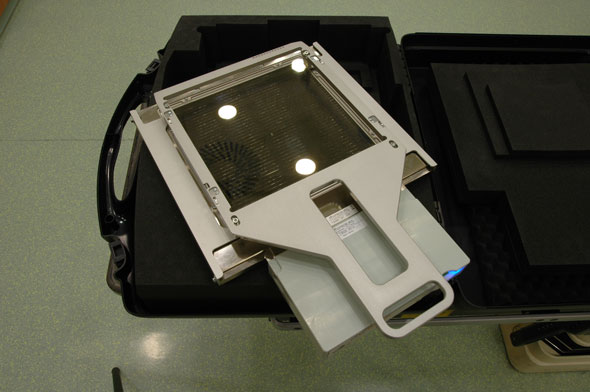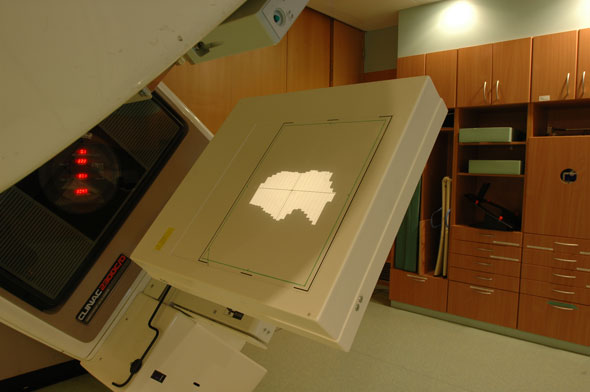If you don't trust your MLC, there are not many possibilities that you have for making sure that during IMRT the fluence patterns are delivered correctly on a daily basis. Of course, one could argue that you shouldn't do IMRT if you don't trust your machine. But depending on your linac/MLC model(1) and your degree of confidence, it may be desirable to have permanent in-vivo monitoring of fluence/dose delivery.
One way to accomplish this on Varian machines is to analyse the Dynamic MLC logfiles (dynalog files) after the treatment. The principle was discussed years ago with a recent update. But this cannot be done on the linacs of all three vendors. The advantage of this approach is that it doesn't interfere with the treatment at all: nobody has to enter the room to attach some equipment to the linac head before the treatment or to remove it afterwards.
The second best approach in terms of interfering with the treatment is probably the wireless DAVID system from PTW Freiburg (see sidebar). The measurement wires, one for each leaf pair, run along the mid-line of the leaves. The wires are placed between two windows which are at a potential of +400 V. During treatment of a MLC field, variable lengths of the wires get exposed to radiation. The ion pairs are collected by the wires. The principle is similar to a thimble ionization chamber with a long central electrode. The signal of each wire can be interpreted as dose length product. Due to the fact that the sensitive volume of each wire is open on the sides, there is some "cross-talk". But in the context of constancy checks, this is no problem: one refers to a reference measurement.
Due to its transparent chamber design, DAVID may stay attached to the collimator the whole day (unless the slot is needed for other things like hard wedges). PTW asserts that the visibility of the light field is not restricted, and that the dosimetric absorption of the transmission chamber can be compensated with a tray factor.

(The device - here in it's carrying case - is slim and lightweight.)

(DAVID is inserted into the slot where the hard wedges and the front
pointer go.)
KFJ testing
For several weeks, we tested the device on our Varian linacs (Clinac 2300C/D with 80-leaf MLC). On one hand, we looked at DAVID as a "passive device". We made dosimetric measurements regarding attenuation, increase of surface dose, etc.
On the other hand we used DAVID actively. We made a usability testing and also looked at potential other usages than the ones intended by PTW.
DAVID (passive)
Putting a device like DAVID into the beam modifies certain beam quality parameters.
- Transmission. DAVID's polycarbonate windows (total thickness: 14 mm) attenuate the beam. This can be expressed by a transmission factor. Light is also attenuated. more...
- Beam Profiles. The rays striking DAVID are not parallel, and they have a radial energy distribution: with increasing radial distance from the central axis they get "softer". Especially in large fields, one can observe that beam profiles with and without DAVID are not identical. more...
- Increase of Surface Dose. Surface dose is increased through secondary electrons originating from the upper and lower windows. The effect depends on SSD, field size and energy. more...
- Depth of Maximum Dose (dmax). The increase of surface dose is accompanied by a shift of dmax to shallower depth. more...

(The good visibility of the light field is demonstrated on the PortalVision detector.)
DAVID (active)
- Configuring ARIA for DAVID. Before DAVID can be used on the Varian linac in clinical mode, ARIA must be configured. more...
- Warmup. After powering on, DAVID should be given some time to stabilize. more...
- Normal IMRT use. We tested the normal usage of the device, thereby assessing DMLC performance at various gantry angles. Our Clinacs are now 14 years old: doing some additional checks after 10 years of intensive IMRT usage probably makes sense! But is it possible to pin down DMLC irregularities by using DAVID? more...
- Dynamic Wedges. Apart from it's intended use, DAVID seems to be the perfect constancy check device for Varian's Enhanced Dynamic Wedge. more...
- Some practical notes. How is the handling? Is Bluetooth working well? more...
- How accurate is DAVID's internal temperature sensor? A desktop measurement session without radiation. more...
- How long does DAVID's battery last? We checked battery performance. more...
(1)... thinking of the only linac vendor who also produces coffeemakers.